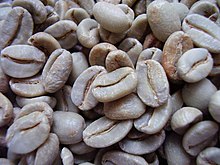Agricultural commodity
Agricultural commodities are raw materials , as unprocessed agricultural products in the nature occur.
General
Agricultural raw materials are among the renewable raw materials . Like other raw materials, they have to be unprocessed, which is why, for example, green coffee is an agricultural raw material, whereas roasted coffee is not because of its processing by roasting . As natural products, agricultural raw materials are the basis for human nutrition ( food ) or animals ( feed ). A new area of application is their use as biomass for energy generation . Agricultural raw materials come from agriculture , which, along with mining , fishing and forestry, is part of the primary production sector . They belong to the commodities , more precisely to the "soft commodities". As far as they can be standardized , they can be traded as a trading object on commodity exchanges.
species
Agricultural raw materials can be divided into the following groups:
- Food and feed :
- Luxury foods : coffee , cocoa , tobacco , tea ;
- Root crops : among others potatoes , cassava , sugar cane and sugar beets ;
- Fruit : types of fruit such as berries , pome fruits , nuts , stone fruits , classic tropical fruits and tropical fruits ;
- Oil plants : in particular avocado , hemp , flax , oil palm , rapeseed , sesame and soy ;
- technical agricultural raw materials: cotton , rubber or wool .
After their further processing through agricultural production, all species become agricultural products that are used either as food, as feed or as biomass. In Germany, 60% of the agricultural area is used for growing food and around 26% for growing feed.
Some authors also include industrial agricultural raw materials such as timber and pulp .
Agricultural commodities as an asset class
Agricultural raw materials represent a separate asset class and are considered alternative investments (commodities). Due to the high volatility of agricultural prices , this asset class is often the subject of speculative investments, so that it is only suitable for risk- taking investors . The counterparties are usually not interested in the physical delivery of the agricultural commodities, but rather in price gains . Standardized agricultural commodities are therefore not invested in stocks, but in futures or short sales of commodities or exchange -traded commodities (ETCs). The investments in agricultural commodities increased from US $ 9 billion in 2003 to US $ 99 billion in 2011.
economic aspects
The supply of agricultural raw materials is very dependent on the weather and can therefore lead to poor harvests due to droughts or floods and also be subject to strong seasonal fluctuations. This can lead to supply gaps or supply surpluses, which can lead to sudden supply or demand shifts . Emerging delivery bottlenecks or overproduction result in high volatility in agricultural prices. Another characteristic is their partially limited shelf life and storability . For these reasons, the supply elasticity is rigid to inelastic with constant consumption . That is why security of supply plays a major role; the degree of self-sufficiency in agricultural raw materials is measured sensitively.
Individual evidence
- ↑ Dieter Eich / Ralf Leonhard, Contested Raw Materials: Markets, Sacrifice, Profiteure , 2013, p. 48
- ↑ Uwe Bergold / Roland Eller, Investment strategies with raw materials , 2006, p. 29
- ↑ Dieter Eich / Ralf Leonhard, Contested Raw Materials: Markets, Sacrifice, Profiteure , 2013, p. 129
